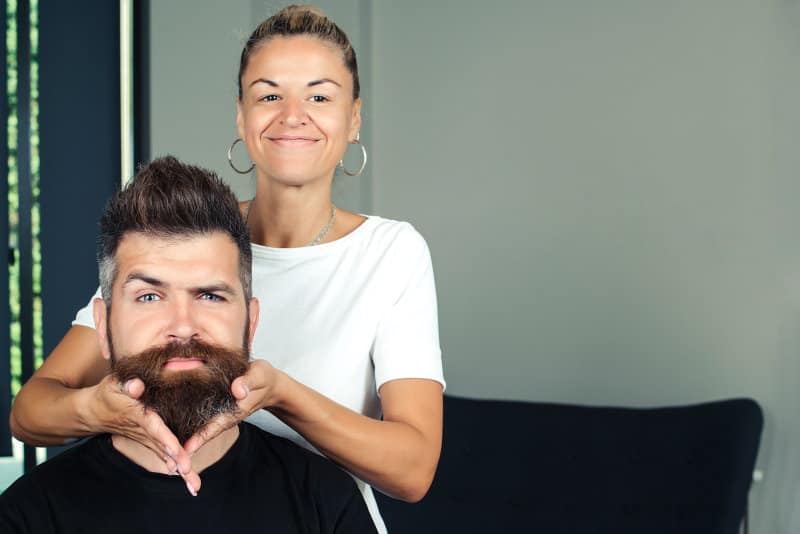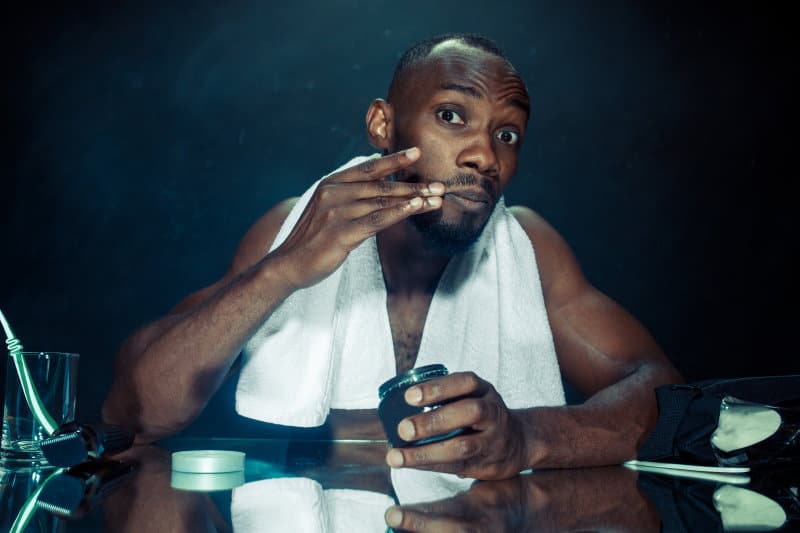In general, anyone trying to seamlessly blend their beard and the hair on their head runs into a problem. Beard hair is naturally much more coarse than scalp hair. This elicits two questions: how can two types of hair on your head be so different, and why exactly is facial hair so coarse?
Essentially, beard hair is a secondary sex characteristic, dependent on male hormones to develop. It’s more comparable to chest hair and pubic hair in its construction. Consequently, it comes in thicker, curlier, and coarser than your more silky scalp hair. You might also be exacerbating beard hair’s coarseness with improper washing and grooming habits.
So, how do you make that mane on your face feel a little less like steel wool? To answer that question, let’s start with a little basic biology…
What is Beard Hair … Really?
To begin, a beard is what’s called a secondary sex characteristic. As a whole, animals mostly differ sexually only based on their reproductive organs. However, some species are sexually dimorphic. This means that they differ physically between the sexes in ways that go beyond genitalia. For example:
- Only male African lions have huge manes.
- Male orangutans have huge cheek flaps, but females don’t.
- Male pheasants have bright, colorful feathers, while females are rather subdued and mostly monochromatic.
Humans are also sexually dimorphic. Women have rolling hips and rounded breasts. Men have chest and facial hair. This is just to name a few differences.
As a secondary sex trait, beard hair requires the presence of masculine hormones like testosterone and DHT – released in large quantities during puberty – to grow. This differs from head hair, which grows without these hormones being present.
So, you see, the hair coming from your scalp and the hair coming out along your jaw are not the same type of hair. This explains why they have differing consistencies. But what is facial hair’s biological purpose?
A Beard’s Biological Purpose

You might have noticed, in the prior section’s animal kingdom examples – that the secondary sex characteristics involved more ornamentation on males. These masculine flourishes, by and large, serve the purpose of attracting mates. You could add to the list above the ornate train of the peacock or the massive proboscis on male elephant seals.
In total, scientific research into male facial hair has uncovered no conclusive biological reason for its existence beyond ornamentation. While beards provide plenty of protection against airborne toxins and extreme weather, there’s no evidence that defense is its evolutionary purpose.
A full, healthy thicket of hair on your face is probably the human equivalent to a huge elephant seal schnoz. It’s a way to indicate to potential mates that you are mature, masculine, and virile.
Why the Wiriness?
For the most part, the hair in men’s beards grows curly, wiry, and stiff. From a physiological perspective, this is a function of the type of hair on your face. It is androgenic, meaning it only emerges after puberty. This type of hair naturally comes in coarser. Compare it to your chest hair and pubic hair, two other examples of androgenic hair.
On average, men have much higher hormone levels than women. (Remember that the next time someone blames hormones for an argument with his girl.) This results in men’s androgenic hair coming in thicker and wirier than women’s. It also explains why we grow beards and women don’t.
Even though human facial hair is a bit of an evolutionary puzzle, it appears to share some functions with other androgenic hair. It warms and insulates, and it clings to natural, pheromone-rich oils.
Incidentally, if you want to get a real-world example of how hormones can affect how our hair grows, consider the common changes pregnant women’s hair undergo. As their hormone levels rise, their hair often darkens, thickens, curls, and becomes shinier.
Are You Coarsening Things?
With the understanding that facial hair – like all androgenic hair – tends to be coarser than scalp hair, you must also consider the possibility that you might be exacerbating the wiriness with how you treat your beard.
The hair on your head and the hair on your face look and feel different because their follicles develop differently. They also have different types of skin underneath. This means you need to clean, condition, and style them differently. Your scalp produces a lot more oil than your face, so shampoos and conditioners for your hair are more aggressive in stripping it away.
If you use these products on your beard and mustache, they will sap it of important, fortifying, softening natural oils.
By the same token, your scalp naturally replenishes oils that repair and moisturize your head follicles. It does this far more efficiently than your face does. As such, your hair might remain soft and lustrous with a little conditioner while your beard grows increasingly dry, brittle, and rough to the touch.
Softening Things Up

What is a beardsman to do, then? We all want a beard that looks healthy, grows well, and feels pleasant to the touch. But we’re behind the eight-ball to a certain extent with facial hair that naturally grows wiry and coarse.
Luckily, there are a few practices you can incorporate into your cleaning and grooming regimen that will soften up that wild mane on your face. Follow these suggestions, and you’ll be on your way to a softer, more pleasant beard:
| Bathing | ● Don’t shower in scalding hot water; this strips your beard of oils it needs. ● Use a beard-specific shampoo and conditioner, which contain naturally-derived oils that moisturize and repair follicles as they wash. ● When you scrub, massage the product all the way to the skin below your facial hair. |
| Grooming | ● Use a beard oil after washing, massaging the product through your dried facial hair and onto the skin below. ● Style your facial hair with a beard balm containing a rejuvenating carrier oil like argan or jojoba. ● Give your beard a nice brush and a comb to straighten and lighten it. ● Trim hairs that are getting out-of-control wiry. |
| Lifestyle | ● Avoid prolonged sun exposure, or take care to wash and moisturize your face after a long day in the sun’s glare. ● Maintain a beard-friendly diet, full of vitamins A, C, and E, plus calcium, zinc, biotin, and healthy fats. |
The Bottom Line
As a general rule, your beard will never be quite as silky, soft, or tamable as the hair on your head. Facial hair is androgenic and therefore much coarser. With that said, there are many things you can do to calm, hydrate, and soften your beard.
Curious about how facial hair develops in puberty? We’ve written about that, and you should check it out!

